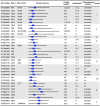The VQ Motif-Containing Protein Family of Plant-Specific Transcriptional Regulators
- PMID: 26220951
- PMCID: PMC4577417
- DOI: 10.1104/pp.15.00788
The VQ Motif-Containing Protein Family of Plant-Specific Transcriptional Regulators
Abstract
The VQ motif-containing proteins (designated as VQ proteins) are a class of plant-specific proteins with a conserved and single short FxxhVQxhTG amino acid sequence motif. VQ proteins regulate diverse developmental processes, including responses to biotic and abiotic stresses, seed development, and photomorphogenesis. In this Update, we summarize and discuss recent advances in our understanding of the regulation and function of VQ proteins and the role of the VQ motif in mediating transcriptional regulation and protein-protein interactions in signaling pathways. Based on the accumulated evidence, we propose a general mechanism of action for the VQ protein family, which likely defines a novel class of transcriptional regulators specific to plants.
© 2015 American Society of Plant Biologists. All Rights Reserved.
Figures



References
-
- Buscaill P, Rivas S (2014) Transcriptional control of plant defence responses. Curr Opin Plant Biol 20: 35–46 - PubMed
-
- Caspersen MB, Qiu JL, Zhang X, Andreasson E, Naested H, Mundy J, Svensson B (2007) Phosphorylation sites of Arabidopsis MAP kinase substrate 1 (MKS1). Biochim Biophys Acta 1774: 1156–1163 - PubMed
-
- Chi Y, Yang Y, Zhou Y, Zhou J, Fan B, Yu JQ, Chen Z (2013) Protein-protein interactions in the regulation of WRKY transcription factors. Mol Plant 6: 287–300 - PubMed
Publication types
MeSH terms
Substances
LinkOut - more resources
Full Text Sources
Other Literature Sources

